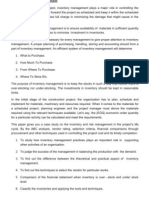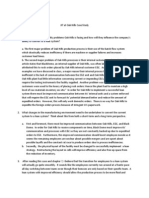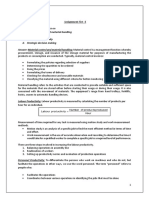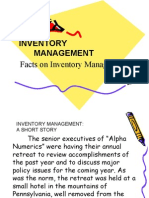Stock Control Notes
Stock Control Notes
Uploaded by
veronica_celestialCopyright:
Available Formats
Stock Control Notes
Stock Control Notes
Uploaded by
veronica_celestialOriginal Description:
Original Title
Copyright
Available Formats
Share this document
Did you find this document useful?
Is this content inappropriate?
Copyright:
Available Formats
Stock Control Notes
Stock Control Notes
Uploaded by
veronica_celestialCopyright:
Available Formats
Stock Control
Managing stock effectively is important for any business, because without enough stock, production and sales
will grind to a halt. Stock control involves careful planning to ensure that the business has sufficient stock of the
right quality available at the right time.
Stock can mean different things and depends on the industry the firm operates in. It includes:
• Raw materials and components from suppliers
• Work in progress or part finished goods made within the business
• Finished goods ready to dispatch to customers
• Consumables and materials used by service businesses
As stock comes in, and gets used, new stock replaces it. This may cause problems in valuing the stock if they
have different values. Well ziperdeedodah! Who cares? This is important because stock value is one of the
components of profit.
There are three ways of valuing stock…
1. FIFO (First in first out). Stock is assumed to be used on the basis of the earliest stuff in was
the first used, so the stock left, and so the stock to be valued is the newest stuff in, and so the price
used to calculate it is the cost of the latest stock in.
2. LIFO (Last in first out). Stock is assumed to be used on the basis of the latest stuff in
was the first used, so the stock left, and so the stock to be valued, is the oldest stuff in. The value is
calculated depending upon the price for the oldest stock used.
3. Average cost. An average value is taken of the cost of all stock over the time
period.
In order to meet customer orders, product has to be available from stock – although some firms are able to
arrange deliveries Just in Time, see below. If a business does not have the necessary stock to meet orders,
this can lead to a loss of sales and a damaged business reputation. This is sometimes called a ‘stock-out’.
It is important therefore that a business either holds sufficient stocks to meet actual and anticipated orders, or
can get stocks quickly enough to meet those orders. For a high street retailer, in practice this means having
product on the shelves.
However, there are many costs of holding stock, so a business does not wish to hold too much stock either.
The costs of holding stock include:
• The opportunity cost of working capital tied up in stock that could have been used for another
purpose
• Storage costs – the rent, heating, lighting and security costs of a warehouse or additional factory or
office space
• Bank interest , if the stock is financed by an overdraft or a loan
• Risk of damage to stock by fire, flood, theft etc; most businesses would insure against this, so there
is the cost of insurance
• Stock may become obsolete if buyer tastes change in favour of new or better products
• Stock may perish or deteriorate – especially with food products
Stock Control - application and evaluation
IB Business & Management
Stock control
Neil.elrick@tes.tp.edu,tw
When a stock control situation is presented in an examination, it is likely to be in the context of a business that
is facing change – so it is rarely as simple as the diagram in the tutor2u stock control revision note.
Candidates need to interpret and apply stock control principles to the particular situation, and make practical
suggestions to help address the question.
Examples might include:
• A business that is growing will need to review its re-order and buffer stock levels, and the frequency
and size of orders
• Look out for seasonality in a business; larger or more frequent orders may be needed in busy times
• If the supplier is having trouble supplying goods on time, the firm might need to re-order at an earlier
point (or seek a new supplier!)
• Does the firm have a back-up supplier in case of delays?
• Could small additional orders be made with a supplier as a stop gap if the firm’s stock runs out suddenly?
Note - these orders would be more expensive because of extra transport costs and lower discount leve
IB Business & Management
Stock control
Neil.elrick@tes.tp.edu,tw
Stock shown graphically
A stock control chart is a graphical illustration of a simple approach to stock management over time. This ‘saw
tooth’ shaped diagram is normally shown as if sales were steady throughout each month. Whilst this
oversimplifies the situation for many businesses, the principles can be adapted to most situations.
The key features and terms are:
• Maximum stock level – this is the maximum amount of stock a business would wish to hold. This
could represent enough stock for a month or a week, it might be as much as the warehouse has space
for, or it might depend on the order size needed to qualify for a quantity discount – known as the
Economic Order Quantity (EOQ). On the diagram below, the maximum stock level is 600 units, and the
usual order quantity is 500 units
• Re-order level – this acts as a trigger point, so that when stocks fall to this level, the next order
should be placed. This helps take account of fluctuations in sales levels over time. When an order is
placed, there is a lead time that the supplier needs to meet that order. Ideally this new order will arrive
just before stocks fall below the minimum stock level. On the diagram below, 300 units
• Lead time – the amount of time between placing the order and receiving the stock On the diagram
below, just under two weeks
• Minimum stock level – this is the minimum amount of product the business would want to hold in
stock. Assuming the minimum stock level is more than zero, this is known as buffer stock – see below.
On the diagram below, 100 units
• Buffer stock – an amount of stock held as a contingency in case of unexpected orders so that such
orders can be met and in case of any delays from suppliers.
IB Business & Management
Stock control
Neil.elrick@tes.tp.edu,tw
Other bits and pieces on stock
Stock-taking
A simple approach to checking the level of stock in a business is to count it on the shelves – this is called stock-
taking. For many businesses, such as a small shop, this is a thoroughly practical approach. Most businesses
conduct an ‘annual stock take’ when stocks are checked in considerable detail to find any discrepancies between
what is physically and the stock records. This is also a good time to check for any obsolete or out of date stock
that needs to be disposed of.
Stock rotation
Most businesses try to use up older stock first to help avoid stock deterioration or becoming obsolete – this is
known as stock rotation. You have probably noticed that supermarkets always load the freshest stock to the
back of the shelves.
Computerised stock control
Large businesses such as the major retailers use computerised systems to manage stocks of tens of thousands
of items, some of which are replenished several times a day. As stock arrives, and again as it is sold, scanning
of bar codes keeps the levels up to date.
Automatic re-ordering of stock
As bar codes on products are scanned at the checkout, the system is taking those sales into account as part of
a program to re-order stock. Rather than manual stock-taking by counting product on the shelves or in the
warehouse, the supermarket has detailed real-time stock level information that the system uses to place re-
orders through EDI (Electronic Data Interchange).
Information such as weather forecasts, public holidays and major sporting events can be used to help
determine the stock level of seasonal products – such as beer, ice cream and food for barbecues. Huge
amounts of data are available from sales around the country to help determine what stock to have in place on
different days of the week and even at different times of the day.
The major supermarkets such as Tesco have developed stock management as one of their core competencies
and derive competitive advantage from having the right stocks on the shelves when customers want them.
Just-in-time (JIT) stock control
JIT stock control means that stock is only ordered to meet specific orders, and little or no product is held in
stock. This requires very responsive and reliable suppliers who can meet stringent requirements to deliver
exactly the right stock to a precise location and within a narrow time frame. See the revision notes on Lean
Production for more details of JIT.
IB Business & Management
Stock control
Neil.elrick@tes.tp.edu,tw
You might also like
- Job Description Accounts Officer ExpenditureNo ratings yetJob Description Accounts Officer Expenditure2 pages
- Case Study: The Renovo Story: Venture Capital at The Cutting EdgeNo ratings yetCase Study: The Renovo Story: Venture Capital at The Cutting Edge10 pages
- Principles of Material Handling AssignmentNo ratings yetPrinciples of Material Handling Assignment27 pages
- Inventory Strategy: Maximizing Financial, Service and Operations Performance with Inventory StrategyFrom EverandInventory Strategy: Maximizing Financial, Service and Operations Performance with Inventory Strategy5/5 (2)
- Matrix (EPSFM) Analysis: 3.1.2 Expanded Problem-Solution Finding50% (2)Matrix (EPSFM) Analysis: 3.1.2 Expanded Problem-Solution Finding21 pages
- A Detailed Lesson Plan in English 10 (How To Select and Limit A Research Topic60% (5)A Detailed Lesson Plan in English 10 (How To Select and Limit A Research Topic8 pages
- Mba201 - Production and Operation ManagementNo ratings yetMba201 - Production and Operation Management8 pages
- How To Audit Warehouse Inventory ChecklistNo ratings yetHow To Audit Warehouse Inventory Checklist4 pages
- Interagency Committee For Property Management (ICPM) Asset Management Review GuideNo ratings yetInteragency Committee For Property Management (ICPM) Asset Management Review Guide76 pages
- Strategic Procurement Management Lecture Notes by Bagaya Ramathan PDF100% (1)Strategic Procurement Management Lecture Notes by Bagaya Ramathan PDF11 pages
- Introduction To Supplies and Materials ManagementNo ratings yetIntroduction To Supplies and Materials Management8 pages
- Internal Marketing Audit Checklist: Operating Results - by Product, Customer, Geographic RegionNo ratings yetInternal Marketing Audit Checklist: Operating Results - by Product, Customer, Geographic Region4 pages
- Chapter 5 - Procurement Policies, Procedures and Support Tools100% (1)Chapter 5 - Procurement Policies, Procedures and Support Tools41 pages
- Ema Uk He Slack Opsman 4 Student Resources Chapter 3 Operations Strategy Multiple-Choice QuestionsNo ratings yetEma Uk He Slack Opsman 4 Student Resources Chapter 3 Operations Strategy Multiple-Choice Questions2 pages
- 1 Aston Manor Academy - Fixed Asset & Depreciation Adopted April 2012No ratings yet1 Aston Manor Academy - Fixed Asset & Depreciation Adopted April 20127 pages
- Procurement Challenges and Solutions - Fleet and Transport ManagementNo ratings yetProcurement Challenges and Solutions - Fleet and Transport Management22 pages
- Group 3: Plant Layout and Industrial Safety100% (1)Group 3: Plant Layout and Industrial Safety16 pages
- (2018) How To Franchise - Petron Bulilit Gas Station PDFNo ratings yet(2018) How To Franchise - Petron Bulilit Gas Station PDF6 pages
- Inventory Management: Organization's Policies, Procedures and Practices May IncludeNo ratings yetInventory Management: Organization's Policies, Procedures and Practices May Include6 pages
- STUDY GUIDE - Common Uc7 Test Elec ComponentsNo ratings yetSTUDY GUIDE - Common Uc7 Test Elec Components4 pages
- Pretest Letter To Parents For ScholasticNo ratings yetPretest Letter To Parents For Scholastic2 pages
- Was or Were Subject-Verb Agreement WorksheetNo ratings yetWas or Were Subject-Verb Agreement Worksheet1 page
- Attention Deficit Hyperactivity DisorderNo ratings yetAttention Deficit Hyperactivity Disorder1 page
- Computer Parts and Accessories: Networking Tools and EquipmentNo ratings yetComputer Parts and Accessories: Networking Tools and Equipment2 pages
- Sentence Patterns: Group Members: Desiree Tungol Kathrine Pechardo Napfisa Maca-AgerNo ratings yetSentence Patterns: Group Members: Desiree Tungol Kathrine Pechardo Napfisa Maca-Ager7 pages
- Education System in Vietnam: by Gambhir Man Tandukar Ph.D. CandidateNo ratings yetEducation System in Vietnam: by Gambhir Man Tandukar Ph.D. Candidate12 pages
- Presented by Group Three: Sentence StructureNo ratings yetPresented by Group Three: Sentence Structure6 pages
- Stakeholder Pressure and The Adoption of Environmental Practices: The Mediating Effect of TrainingNo ratings yetStakeholder Pressure and The Adoption of Environmental Practices: The Mediating Effect of Training15 pages
- Legal Presence in US Declaration FORM PDFNo ratings yetLegal Presence in US Declaration FORM PDF1 page
- Dilg Region Ix: Project Development & Management UnitNo ratings yetDilg Region Ix: Project Development & Management Unit10 pages
- Chapter# Feasibility Study, Project Proposal and Project AppraisalNo ratings yetChapter# Feasibility Study, Project Proposal and Project Appraisal10 pages
- Brochure - Architectural Coatings Market - Global Forecast To 2023 PDFNo ratings yetBrochure - Architectural Coatings Market - Global Forecast To 2023 PDF30 pages
- Victorialeong@Ntu - Edu.Sg: Hp1000 Introduction To Psychology (Ay2020/2021 Semester 1)No ratings yetVictorialeong@Ntu - Edu.Sg: Hp1000 Introduction To Psychology (Ay2020/2021 Semester 1)2 pages
- US VS Salaveria G.R. No. 13678. November 12, 1918No ratings yetUS VS Salaveria G.R. No. 13678. November 12, 19188 pages
- Mirpur University of Science & Technology, MUST Mirpur AJ&K: InstructionsNo ratings yetMirpur University of Science & Technology, MUST Mirpur AJ&K: Instructions2 pages
- Purposive Communication Element 1: Opening Statements: Use Had Better To Give Urgent AdviceNo ratings yetPurposive Communication Element 1: Opening Statements: Use Had Better To Give Urgent Advice5 pages
- National Open University of Nigeria: Course Code:-Pcr261No ratings yetNational Open University of Nigeria: Course Code:-Pcr261222 pages
- WB UB16 Powertec Utility Bench Assembly Manual0% (1)WB UB16 Powertec Utility Bench Assembly Manual12 pages
- 544 Hillside Rd. Redwood City, CA 94062 USA PH: 1.650.260.2387 Fax: 1.650.260.2389No ratings yet544 Hillside Rd. Redwood City, CA 94062 USA PH: 1.650.260.2387 Fax: 1.650.260.23892 pages
- What Are Essential Questions - The Second PrincipleNo ratings yetWhat Are Essential Questions - The Second Principle7 pages
- Using The ADDIE Model To Develop Online Continuing Education Courses On Caring For Nurses in TaiwanNo ratings yetUsing The ADDIE Model To Develop Online Continuing Education Courses On Caring For Nurses in Taiwan10 pages
- Case Study: The Renovo Story: Venture Capital at The Cutting EdgeCase Study: The Renovo Story: Venture Capital at The Cutting Edge
- Inventory Strategy: Maximizing Financial, Service and Operations Performance with Inventory StrategyFrom EverandInventory Strategy: Maximizing Financial, Service and Operations Performance with Inventory Strategy
- Organizational Readiness to E-TransformationFrom EverandOrganizational Readiness to E-Transformation
- Matrix (EPSFM) Analysis: 3.1.2 Expanded Problem-Solution FindingMatrix (EPSFM) Analysis: 3.1.2 Expanded Problem-Solution Finding
- A Detailed Lesson Plan in English 10 (How To Select and Limit A Research TopicA Detailed Lesson Plan in English 10 (How To Select and Limit A Research Topic
- Interagency Committee For Property Management (ICPM) Asset Management Review GuideInteragency Committee For Property Management (ICPM) Asset Management Review Guide
- Strategic Procurement Management Lecture Notes by Bagaya Ramathan PDFStrategic Procurement Management Lecture Notes by Bagaya Ramathan PDF
- Internal Marketing Audit Checklist: Operating Results - by Product, Customer, Geographic RegionInternal Marketing Audit Checklist: Operating Results - by Product, Customer, Geographic Region
- Chapter 5 - Procurement Policies, Procedures and Support ToolsChapter 5 - Procurement Policies, Procedures and Support Tools
- Ema Uk He Slack Opsman 4 Student Resources Chapter 3 Operations Strategy Multiple-Choice QuestionsEma Uk He Slack Opsman 4 Student Resources Chapter 3 Operations Strategy Multiple-Choice Questions
- 1 Aston Manor Academy - Fixed Asset & Depreciation Adopted April 20121 Aston Manor Academy - Fixed Asset & Depreciation Adopted April 2012
- Procurement Challenges and Solutions - Fleet and Transport ManagementProcurement Challenges and Solutions - Fleet and Transport Management
- (2018) How To Franchise - Petron Bulilit Gas Station PDF(2018) How To Franchise - Petron Bulilit Gas Station PDF
- Inventory Management: Organization's Policies, Procedures and Practices May IncludeInventory Management: Organization's Policies, Procedures and Practices May Include
- Computer Parts and Accessories: Networking Tools and EquipmentComputer Parts and Accessories: Networking Tools and Equipment
- Sentence Patterns: Group Members: Desiree Tungol Kathrine Pechardo Napfisa Maca-AgerSentence Patterns: Group Members: Desiree Tungol Kathrine Pechardo Napfisa Maca-Ager
- Education System in Vietnam: by Gambhir Man Tandukar Ph.D. CandidateEducation System in Vietnam: by Gambhir Man Tandukar Ph.D. Candidate
- Stakeholder Pressure and The Adoption of Environmental Practices: The Mediating Effect of TrainingStakeholder Pressure and The Adoption of Environmental Practices: The Mediating Effect of Training
- Dilg Region Ix: Project Development & Management UnitDilg Region Ix: Project Development & Management Unit
- Chapter# Feasibility Study, Project Proposal and Project AppraisalChapter# Feasibility Study, Project Proposal and Project Appraisal
- Brochure - Architectural Coatings Market - Global Forecast To 2023 PDFBrochure - Architectural Coatings Market - Global Forecast To 2023 PDF
- Victorialeong@Ntu - Edu.Sg: Hp1000 Introduction To Psychology (Ay2020/2021 Semester 1)Victorialeong@Ntu - Edu.Sg: Hp1000 Introduction To Psychology (Ay2020/2021 Semester 1)
- Mirpur University of Science & Technology, MUST Mirpur AJ&K: InstructionsMirpur University of Science & Technology, MUST Mirpur AJ&K: Instructions
- Purposive Communication Element 1: Opening Statements: Use Had Better To Give Urgent AdvicePurposive Communication Element 1: Opening Statements: Use Had Better To Give Urgent Advice
- National Open University of Nigeria: Course Code:-Pcr261National Open University of Nigeria: Course Code:-Pcr261
- 544 Hillside Rd. Redwood City, CA 94062 USA PH: 1.650.260.2387 Fax: 1.650.260.2389544 Hillside Rd. Redwood City, CA 94062 USA PH: 1.650.260.2387 Fax: 1.650.260.2389
- What Are Essential Questions - The Second PrincipleWhat Are Essential Questions - The Second Principle
- Using The ADDIE Model To Develop Online Continuing Education Courses On Caring For Nurses in TaiwanUsing The ADDIE Model To Develop Online Continuing Education Courses On Caring For Nurses in Taiwan



















































































































